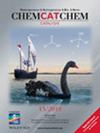Ni-CeO2 双金属催化剂在将甲烷有效分解为氢气和丝状纳米碳方面的协同效应
IF 3.8
3区 化学
Q2 CHEMISTRY, PHYSICAL
引用次数: 0
摘要
该研究试图合成在多孔碳模板上支撑的镍铈双金属催化剂,其在 850 ℃ 下具有热稳定性,用于将甲烷脱氢为氢气和碳纳米结构。通过改变铈的含量(30Ni-5CeO2/AC、30Ni-10Ce O2/AC 和 30Ni-15CeO2/AC),采用萌发湿法浸渍合成了一系列双金属镍催化剂。在这组双金属催化剂中,30Ni-5CeO2/AC 催化剂的甲烷转化率和稳定性最高。在甲烷进料浓度为 40% 的情况下,甲烷转化率最高可达 90%,而且催化剂稳定性良好。低浓度的促进剂铈增强了金属在催化表面的分散,从而产生了充分的金属-支撑相互作用。碳载体和促进剂铈能够增强镍催化剂的热稳定性,最高温度可达 850 °C,从而提供了高转化率和催化剂稳定性,这也是这项工作的亮点。研究人员采用先进的分析技术对催化剂在反应前后的结构、质地和形态特性进行了表征。对性能最好的催化剂进行的形态学研究表明,通过尖端生长机制形成的致密碳纳米管具有很高的纵横比。本文章由计算机程序翻译,如有差异,请以英文原文为准。
Synergetic effect of Ni-CeO2 bimetallic catalyst for an effective decomposition of methane to hydrogen and filamentous nanocarbons
The work attempts to synthesis nickel-ceria bimetallic catalysts supported on porous carbon template, thermally stable at 850 °C, for dehydrogenation of methane to hydrogen and carbon nanostructures. A series of bimetallic Ni catalysts were synthesized by varying the % ceria content (30Ni-5CeO2/AC, 30Ni-10Ce O2/AC, and 30Ni-15CeO2/AC) using the incipient wetness impregnation approach. Among the set of bimetallic catalysts, the 30Ni-5CeO2/AC catalyst was found to offer highest methane conversion and stability. A maximum conversion of 90% was achieved with 40% methane feed concentration along with good catalyst stability. The promoter ceria at low concentration enhanced the dispersion of metal over the catalytic surface, resulting in adequate metal-support interaction. The ability of the carbon support along with promoter ceria enhanced the thermal stability of the Ni catalyst up to 850 °C, offering high conversion and catalyst stability has been the highlight of the work. Advanced analytical techniques were used to characterize the catalyst's structural, textural, and morphological properties both before and after the reaction. The morphological study of the best-performing catalyst demonstrated the formation of dense carbon nanotubes through tip-growth mechanism exhibiting a high aspect ratio.
求助全文
通过发布文献求助,成功后即可免费获取论文全文。
去求助
来源期刊

ChemCatChem
化学-物理化学
CiteScore
8.10
自引率
4.40%
发文量
511
审稿时长
1.3 months
期刊介绍:
With an impact factor of 4.495 (2018), ChemCatChem is one of the premier journals in the field of catalysis. The journal provides primary research papers and critical secondary information on heterogeneous, homogeneous and bio- and nanocatalysis. The journal is well placed to strengthen cross-communication within between these communities. Its authors and readers come from academia, the chemical industry, and government laboratories across the world. It is published on behalf of Chemistry Europe, an association of 16 European chemical societies, and is supported by the German Catalysis Society.
 求助内容:
求助内容: 应助结果提醒方式:
应助结果提醒方式:


